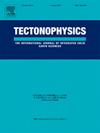Spatiotemporal evolution of a deep short-term slow slip event in the Nankai subduction zone in November 2022 derived from strain, tilt, and GNSS records
IF 2.6
3区 地球科学
Q2 GEOCHEMISTRY & GEOPHYSICS
引用次数: 0
Abstract
This study investigated the spatiotemporal evolution of a deep short-term slow slip event (SSE) in southwest Japan using three geodetic data types: tilt, strain, and GNSS. Because tilt and strain data are more sensitive to crustal deformation than GNSS data, their joint use enables us to estimate the detailed spatiotemporal evolution of SSE slip. In addition, a higher sampling rate of tilt and strain data improves their temporal resolution down to sub-daily time scales. We developed a geodetic inversion method jointly using the three types of geodetic data, and obtained the spatiotemporal evolution of an SSE slip, which occurred beneath the western Shikoku region in November 2022. Comparing results from all possible combinations of data types, we found that the small early-stage SSE slip could be resolved only when strain data was included in the dataset, which is considered to have the highest sensitivity to crustal deformation among the sensors. With the improved spatiotemporal resolution, we compared the spatiotemporal evolution of the SSE slip with that of tremor activities. The initiation timing of the SSE was consistent with the timing when tremor activities were initiated. SSE slips were spatiotemporally collocated with tremor activities, with a moment evolution quantitatively consistent with tremor energy radiation. The scaling factor between the aseismic moment of SSE and the seismic energy of tremor was estimated to be 10−11. However, it is unclear whether we can regard this value as the scaled energy of a slow earthquake because some tremor energy might be missed through the tremor detection process. Our results show that joint use of tilt and strain is especially useful in obtaining not only spatial, but also spatiotemporal evolution of small SSE slip in southwest Japan and that SSE and tremors are representations of a single broadband slip phenomenon in different frequency bands.
基于应变、倾斜和GNSS记录的2022年11月南开俯冲带深部短期慢滑事件时空演化
利用倾斜、应变和GNSS三种大地测量数据类型,研究了日本西南部一次深短期慢滑事件的时空演变。由于倾斜和应变数据比GNSS数据对地壳变形更敏感,因此它们的联合使用使我们能够估计SSE滑动的详细时空演变。此外,倾角和应变数据的较高采样率提高了它们的时间分辨率,直至亚日时间尺度。利用三种类型的大地测量数据联合开发了一种大地测量反演方法,并获得了2022年11月发生在四国西部地区的SSE滑动的时空演变。比较所有可能的数据类型组合的结果,我们发现只有在数据集中包含应变数据时才能解决早期SSE小滑动,这被认为是对地壳变形灵敏度最高的传感器。在改进的时空分辨率下,我们比较了SSE滑动的时空演变与震颤活动的时空演变。SSE的起始时间与震颤活动起始时间一致。SSE滑动在时空上与地震活动重合,其矩演化在数量上与地震能量辐射一致。SSE地震矩与地震能量之间的标度因子为10−11。然而,由于在地震检测过程中可能会遗漏一些地震能量,因此我们是否可以将该值视为慢震的标度能量尚不清楚。我们的研究结果表明,联合使用倾斜和应变不仅对获得日本西南部小SSE滑动的空间和时空演变特别有用,并且SSE和地震是不同频段单个宽带滑动现象的表征。
本文章由计算机程序翻译,如有差异,请以英文原文为准。
求助全文
约1分钟内获得全文
求助全文
来源期刊

Tectonophysics
地学-地球化学与地球物理
CiteScore
4.90
自引率
6.90%
发文量
300
审稿时长
6 months
期刊介绍:
The prime focus of Tectonophysics will be high-impact original research and reviews in the fields of kinematics, structure, composition, and dynamics of the solid arth at all scales. Tectonophysics particularly encourages submission of papers based on the integration of a multitude of geophysical, geological, geochemical, geodynamic, and geotectonic methods
 求助内容:
求助内容: 应助结果提醒方式:
应助结果提醒方式:


